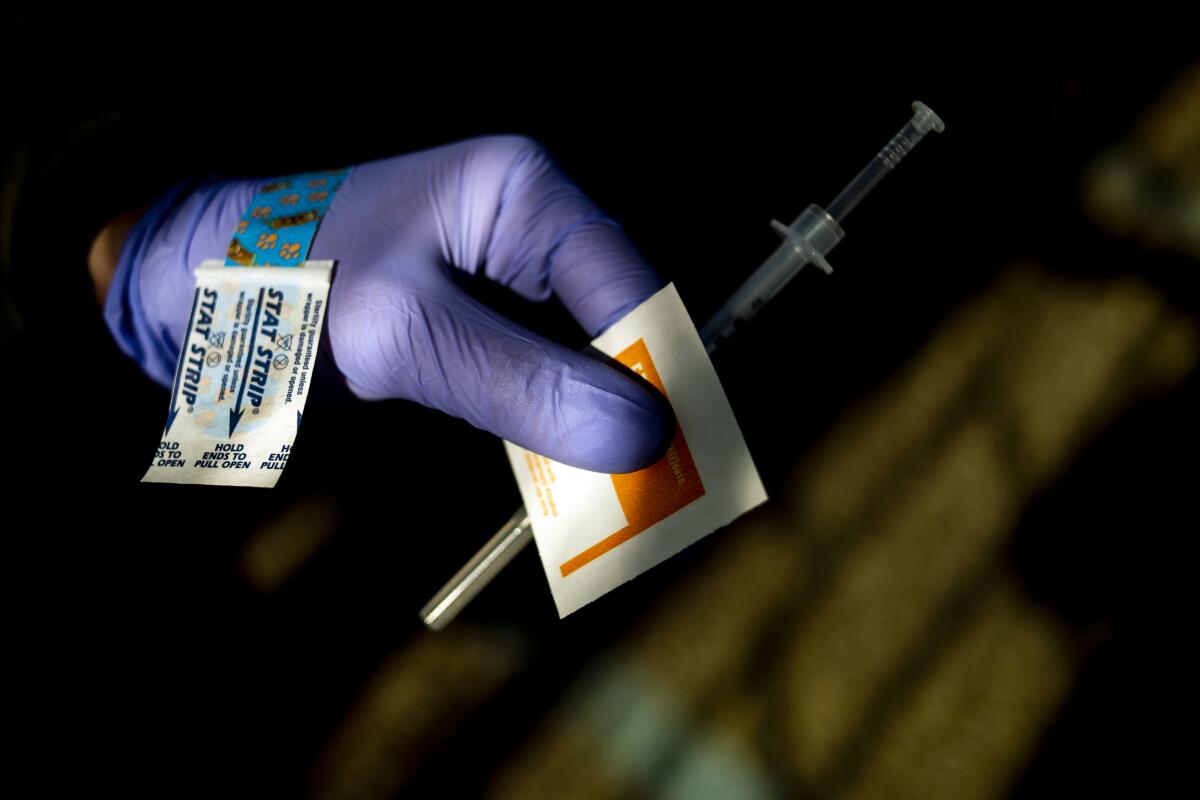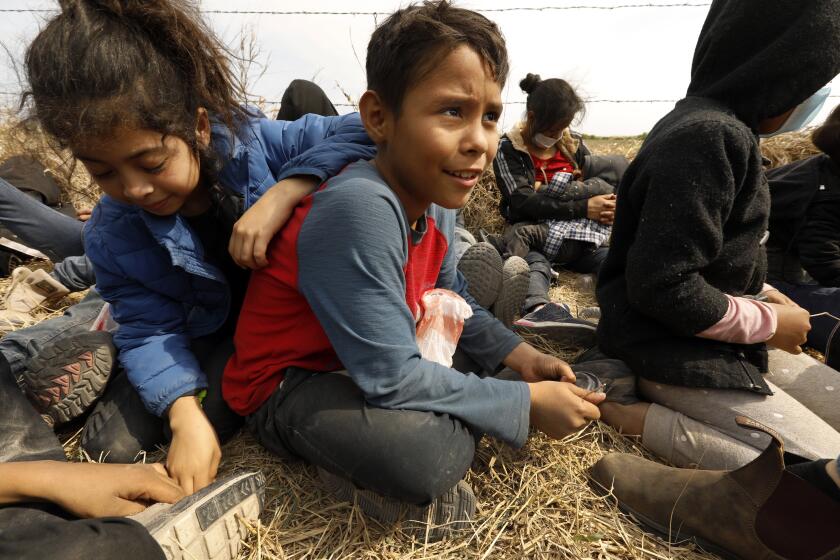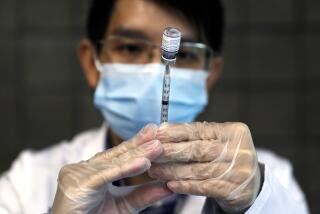Many still hesitate to get vaccine, but reluctance is easing

- Share via
So few people came for COVID-19 vaccinations in one county in North Carolina that hospitals there were allowing anyone 16 or older to get a shot, regardless of where they live. Get a shot, get a free doughnut, the governor said.
Alabama, which has the nation’s lowest vaccination rate and a county where only 7% of residents are fully vaccinated, launched a campaign to convince people the shots were safe. Doctors and pastors joined the effort.
On the national level, the Biden administration this week launched a “We Can Do This” campaign to encourage holdouts to get vaccinated against the coronavirus, which has claimed more than 550,000 lives in the U.S.
The race is on to vaccinate as many people as possible, but a significant number of Americans are, so far, reluctant to get the shots, even in places where they are plentiful. Twenty-five percent of Americans say they probably or definitely will not get vaccinated, according to a new poll from the Associated Press-NORC Center for Public Affairs Research.
They are leery about possible side effects. They tend to be Republican, and they are usually younger and less susceptible to becoming critically ill or dying if they catch COVID-19.
There’s been a slight shift, though, since the first weeks of the nation’s largest-ever vaccination campaign, which began in mid-December. An AP-NORC poll conducted in late January showed that 67% of adult Americans were willing to get vaccinated or had already received at least one shot. Now that figure has increased to 75%.
As more young migrants arrive at the U.S. border alone, overcrowding at Border Patrol facilities and delays in releasing the children worsen.
That, experts say, moves the nation closer to herd immunity, which occurs when enough people have immunity, either from vaccination or past infection, to stop uncontrolled spread of a disease.
Anywhere from 75% to 85% of the total population — including children, who are not currently getting the shots — should be vaccinated to reach herd immunity, said Ali Mokdad, professor of health metrics sciences at the University of Washington School of Public Health.
A little over three months after the first doses were given, 100 million Americans, or about 30% of the population, have received at least one dose.
Andrea Richmond, a 26-year-old freelance web coder in Atlanta, is among those whose reluctance is easing. A few weeks ago, Richmond was leaning toward not getting the shot. Possible long-term effects worried her. She knew that an H1N1 vaccine used years ago in Europe increased risk of narcolepsy.
Then her sister was vaccinated and suffered no ill effects. Richmond’s friends’ opinions also changed.
“They went from, ‘I’m not trusting this’ to ‘I’m all vaxxed up, let’s go out!’”
Her mother, a cancer survivor whom Richmond lives with, is so keen for her daughter to get vaccinated that she signed her up online for a jab.
“I’ll probably end up taking it,” Richmond said. “I guess it’s my civic duty.”
But some remained steadfastly opposed.
“I think I only had the flu once,” said Lori Mansour, 67, who lives near Rockford, Ill. “So I think I’ll take my chances.”
In the latest poll, Republicans remained more likely than Democrats to say they would probably or definitely not get vaccinated, 36% compared with 12%. But somewhat fewer Republicans today are reluctant. Back in January, 44% said they would shy away from a vaccine.
The hesitance can be seen in Alabama’s rural Winston County, which is 96% white and where more than 90% of voters backed then-President Trump last year. Only 6.9% of the county’s roughly 24,000 residents are fully vaccinated, the lowest level in Alabama.
Elsewhere in Alabama, health officials tried to counter problems that included reluctance in heavily Black areas where distrust of government medical initiatives runs deep. They targeted a few counties with a pro-vaccine message, especially in the old plantation region, where a large percentage of the population is Black and many are poor.
The campaign enlisted doctors and pastors and used virtual meetings and the radio to spread the word.
Dr. Karen Landers, assistant state health officer, said the effort had positive results. For example, in Perry County, where 68% of the population of about 9,300 is Black, more than 16% of the population is fully vaccinated, among the highest levels. Officials probably will make similar efforts for other parts of the state, she said.
Nationwide, 24% of Black Americans and 22% of Latino Americans say they will probably or definitely not get vaccinated, down from 41% and 34% in January, respectively. Among white Americans, 26% now say they will not get vaccinated. In January, that number was 31%.
The Biden administration’s campaign features TV and social media ads. Celebrities and community and religious figures are joining the effort.
Iowa Gov. Kim Reynolds, a Republican, is trying win over the one-third of adult Iowans who will not commit to getting a vaccine by emphasizing that the shots will help return life to normal.
In North Carolina’s Cumberland County, fewer than 1 in 6 residents have gotten at least one shot.
Amid worries there would be an unused surplus of vaccines, Cape Fear Valley Health hospital systems opened up the shots last week to everyone 16 or older.
“Rather than have doses go unused, we want to give more people the chance to get their vaccine,” said Chris Tart, a Cape Fear Valley Health vice president. “We hope this will encourage more people to roll up their sleeve.”
On Wednesday, Gov. Roy Cooper, a Democrat, tweeted a video of himself getting a free doughnut from the Krispy Kreme chain. Customers who show their vaccine card can get a free doughnut every day for the rest of the year.
“Do it today, guys!” Cooper encouraged viewers. Nearly 36% of North Carolina adults have been at least partially vaccinated, state data show.
Younger people are more likely to forgo a shot. Of those younger than 45, 31% say they will probably or definitely forgo a shot. Only 12% of those 60 and older say they will not get vaccinated.
Ronni Peck, a 40-year-old mother of three from Los Angeles, is one of those who plans to avoid getting vaccinated, at least for now. She’s concerned that vaccines have not been studied for long-term health effects.
Deborah Fuller, a professor with the University of Washington School of Medicine, said if the herd immunity level could not be reached soon, a more realistic target could be vaccinating at least 50% of the population by this summer, with a higher vaccination rate among the most vulnerable to reduce severe disease, hospitalizations and deaths.
“In this scenario, the virus would persist in the population,” Fuller said, but it would cease to overburden healthcare systems.
More to Read
Sign up for Essential California
The most important California stories and recommendations in your inbox every morning.
You may occasionally receive promotional content from the Los Angeles Times.














